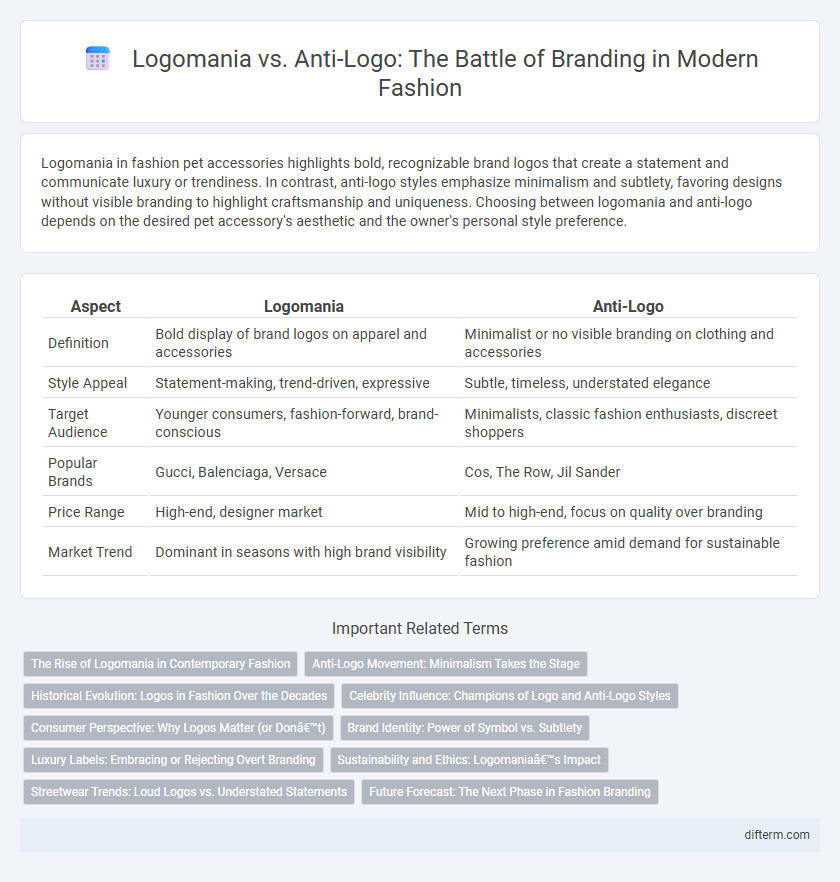Logomania in fashion pet accessories highlights bold, recognizable brand logos that create a statement and communicate luxury or trendiness. In contrast, anti-logo styles emphasize minimalism and subtlety, favoring designs without visible branding to highlight craftsmanship and uniqueness. Choosing between logomania and anti-logo depends on the desired pet accessory's aesthetic and the owner's personal style preference.
Table of Comparison
| Aspect | Logomania | Anti-Logo |
|---|---|---|
| Definition | Bold display of brand logos on apparel and accessories | Minimalist or no visible branding on clothing and accessories |
| Style Appeal | Statement-making, trend-driven, expressive | Subtle, timeless, understated elegance |
| Target Audience | Younger consumers, fashion-forward, brand-conscious | Minimalists, classic fashion enthusiasts, discreet shoppers |
| Popular Brands | Gucci, Balenciaga, Versace | Cos, The Row, Jil Sander |
| Price Range | High-end, designer market | Mid to high-end, focus on quality over branding |
| Market Trend | Dominant in seasons with high brand visibility | Growing preference amid demand for sustainable fashion |
The Rise of Logomania in Contemporary Fashion
The rise of logomania in contemporary fashion marks a significant shift as luxury brands prominently display oversized logos on apparel and accessories to boost brand visibility and consumer status signaling. This trend contrasts with the minimalistic anti-logo movement, which emphasizes subtlety and understated design, appealing to consumers seeking timeless elegance without overt branding. The resurgence of bold logos reflects a broader cultural demand for identity expression and brand loyalty in an increasingly competitive fashion market.
Anti-Logo Movement: Minimalism Takes the Stage
The Anti-Logo Movement champions minimalism by emphasizing clean lines, solid colors, and understated designs that reject flashy branding. This trend reflects a shift towards sustainable fashion and personal expression without overtly displaying brand identities. Consumers increasingly favor versatile, timeless pieces that prioritize quality and subtlety over conspicuous logos.
Historical Evolution: Logos in Fashion Over the Decades
Logomania surged in the 1980s and 1990s as luxury brands like Gucci and Louis Vuitton prominently displayed their logos to symbolize status and exclusivity. The early 2000s saw a shift toward anti-logo movements championed by designers such as Jil Sander and Phoebe Philo, emphasizing minimalism and understated branding. Recent years highlight a cyclical return to bold logos fused with streetwear culture, reflecting the dynamic interplay between identity expression and brand visibility in fashion history.
Celebrity Influence: Champions of Logo and Anti-Logo Styles
Celebrity influence drives the dynamic clash between logomania and anti-logo fashion trends, with stars like Rihanna and Kanye West championing bold, brand-emblazoned apparel that fuels the popularity of logos as status symbols. In contrast, figures such as Jaden Smith and Phoebe Philo advocate for minimalist, anti-logo styles, promoting subtlety and individuality over conspicuous branding. This celebrity-driven dichotomy shapes consumer behavior and retail strategies, reinforcing the cultural significance of brand visibility versus understated elegance in contemporary fashion.
Consumer Perspective: Why Logos Matter (or Don’t)
Consumers drawn to logomania view prominent logos as status symbols that convey brand loyalty and social identity, enhancing perceived value and exclusivity. Conversely, advocates of anti-logo fashion prioritize minimalism and individuality, rejecting overt branding to emphasize personal style and authenticity over corporate symbolism. The choice between logomania and anti-logo reflects deeper consumer desires for either recognition through visible affiliation or subtlety through understated design.
Brand Identity: Power of Symbol vs. Subtlety
Logomania leverages bold, recognizable symbols to create instant brand recall and assert a powerful market presence, driving consumer loyalty through visual dominance. In contrast, anti-logo branding embraces subtlety and minimalism, relying on understated design to convey sophistication and invite deeper consumer engagement. Both strategies shape brand identity by balancing visibility and exclusivity, reflecting evolving consumer preferences in the fashion industry.
Luxury Labels: Embracing or Rejecting Overt Branding
Luxury labels are polarizing trends between logomania, flaunting bold, oversized logos as status symbols, and anti-logo fashion, which embraces subtlety and craftsmanship over conspicuous branding. Iconic brands like Gucci and Louis Vuitton capitalize on logomania to reinforce exclusivity and cultural relevance, while emerging designers and heritage houses focus on minimalist designs to attract discerning consumers seeking authenticity. This dynamic highlights a broader shift within luxury fashion where the power of brand identity oscillates between overt visibility and understated elegance.
Sustainability and Ethics: Logomania’s Impact
Logomania's emphasis on visible branding often drives overconsumption and fast fashion, intensifying environmental harm and ethical concerns within the industry. Anti-logo fashion promotes sustainability by encouraging timeless, minimalist designs that reduce waste and support ethical production practices. This shift fosters conscious consumerism, prioritizing durability and transparency over fleeting brand visibility.
Streetwear Trends: Loud Logos vs. Understated Statements
Streetwear trends sharply contrast logomania, where bold, oversized logos create high visibility and brand recognition, against anti-logo styles that emphasize minimalism and subtle branding for a refined, understated look. Consumers increasingly toggle between loud logos from brands like Supreme and Off-White, and discrete designs favored by labels such as A.P.C. and Acne Studios. This dichotomy reflects evolving preferences for personal expression through fashion, balancing ostentatious identity markers with sleek, minimalist aesthetics.
Future Forecast: The Next Phase in Fashion Branding
Logomania's bold, visible branding will evolve to incorporate subtle, personalized motifs driven by AI customization, blending brand identity with individual expression. Anti-logo fashion will gain momentum through sustainable, minimalist designs emphasizing craftsmanship over conspicuous branding, appealing to eco-conscious consumers. Future fashion branding will balance expressive logos with quiet luxury, leveraging advanced materials and digital integration to create adaptive, experiential apparel.
logomania vs anti-logo Infographic

 difterm.com
difterm.com